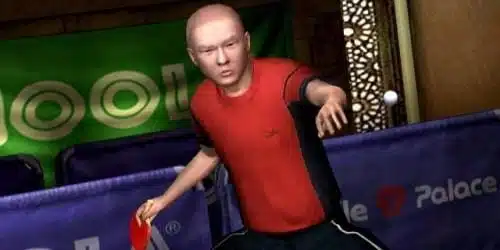
I have to admit that Rockstar Games Presents Table Tennis was one of the reasons I bought an Xbox 360. That likely puts me in the minority, but every time I read something about the game prior to its release, my interest was piqued further and further, till I finally had to find out for myself. In its 360 incarnation, Table Tennis was fast-paced, tense, and controlled nearly perfectly once you got the hang of it. I chose to ignore the face button control scheme in favor of the, in my opinion, far more organic dual analog setup. As such, Table Tennis played like a much more intense version of Virtua Tennis, and as rallies got higher and higher, it was pretty easy to enter a Zen-like state of doing without thinking. As such an ardent fan of the original, I was looking very forward to the game’s Wii incarnation. I was expecting the obvious motion controls that would, hopefully, make the connection with the game even more fluid and polished.
Although the Wii version of Table Tennis offers players three separate control schemes, none seem to take full advantage of the Wii remote. All require you to use the Wiimote to swing, which seems obvious, but they all also require you to hold the D-pad to impart spin. While this sufficiently translates the face button control scheme from the 360 version, it offers no such corollary to the dual analog setup. The natural extension of that setup would see the player moving with the nunchuck, and simply swinging the Wii remote, with spin based on the tilt and direction of the control, as though it really were a table tennis paddle.
From the time that the game was announced, I expected this control scheme, because it seems to make the most sense. Not being a part of the development team, however, I cannot comment on technical issues that may have precluded such an implementation. That said, other games, like WarioWare: Smooth Moves, have certainly made great use of the remote’s position and rotation. Another problem is that because the D-Pad is located so high up on the Wii controller, it feels less like you’re holding a paddle by the handle, and more like you’re choking up on a bat.
The issue here is that Table Tennis for the 360 set the bar quite high on a number of fronts. The graphics were stellar. The control was basic yet deep. But perhaps most importantly, the game defied the image of what sort of title Rockstar would make. Undoubtedly it’s a great game, made better by the element of surprise inherent in the realization that Rockstar had put its trademark polish on something so simple. Clearly, the Wii version cannot really compete as far as graphics and so-called “surprise factor” go. And while the controls are serviceable, and certainly not frustrating once you get used to them, they don’t do justice to what we had imagined the game would be.
Goodbye, equilibrium.
At this point, roughly a year after its release, it seems reasonable to say that the Wii remote can offer a tremendously involving and different control interface, as is the case with games like Metroid Prime 3: Corruption. The other side to that coin, though, has to do with customization. It seems as though the ability to customize the controls for a console game has become ubiquitous enough to be almost expected. In this example, Rockstar has attempted to offer some degree of customization (or at least choice) to the player as far as controls go. It’s not, however, clear how well the concept of customization maps to something like the Wiimote, given its limited button set and the fact that a good deal of its function is mapped to motion and position. Certainly, there are ways to tweak sensitivity and things like that. Super Smash Brothers: Brawl promises markedly different control schemes. Still, even this seems different from the normal button-remapping style of customization that players are used to. Perhaps there will need to be some sort of adjustment period for both developers and players.
Again, as the control is the key difference between the two versions of Table Tennis, it’s not only easy to pick on, but unfortunately, it necessarily comprises the meat of this review. That is not to say that Table Tennis on the Wii is neither fun nor a good game. It genuinely is, particularly for the bargain price it’s being offered at, though it does exclude the online portion found in the original. It remains tense, deep, and challenging. Though the game’s stripped down presentation is less of a statement on the Wii than it was on the 360, it still makes sense, placing the focus squarely on the gameplay. In the face of ever more complicated games with more complicated control schemes, such a distilled experience is welcome.
With Table Tennis, both for the Wii and 360, Rockstar has demonstrated that they are capable of making a fun game that warrants no controversy. I certainly hope that they continue to explore that space, because they clearly have a talent for making games that are enjoyable to play, regardless of subject matter.

